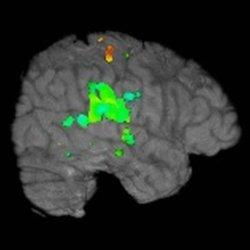
MRI of brain activity following stimulus
CCNY Prof Tony Ro reports new insights on synesthesia at Acoustical Society of America Conference
The high whine of a hovering mosquito makes the skin tingle and crawl. Some sounds, such as fingernails screeching down a blackboard or the throbbing bass of a cranked-up car stereo, are felt as much as heard.
These feelings result from cross-wiring of senses in the brain, according to City College of New York Professor of Psychology Tony Ro. He explained this phenomenon and its relation to a disorder of sensory mixing called synesthesia in an invited paper he presented Wednesday, May 25, at the 161st Meeting of the Acoustical Society of America (ASA) in Seattle.
To determine how sensory mixing occurs, Professor Ro and colleagues traced the neural pathways of sound and touch in the brain. The experimenters played varied sounds through headphones to subjects who were either seated in sound-muffling testing chambers or lying in a magnetic imaging scanner.
To test the brain’s reaction to touch, they connected subjects’ hands or feet to ”vibrotactile stimulators,“ small devices that vibrate much like a muted cellphone. In both cases, they monitored which part of the brain responded to the stimulus.
They found that in the normal brain, the target regions were adjacent to each other or were mingled. A region of the brain known to process feelings of touch also responded to sounds.
The neural architecture was more interwoven for a woman with brain damage, however. She had acquired synesthesia, a pronounced form of sensory confusion in which patients might “taste” shapes or words or “see” musical notes or numbers as colors. In this case, the subject said she felt sounds as touch on the left side of her body.
In other studies, Professor Ro and colleagues measured brain activity with magnetic resonance imaging, electroencephalography and optical imaging. They also disrupted brain activity to see how different brain areas managed interactions between the senses.
From these experiments they learned that physical connections shared between brain regions for sound and touch passed sensory information back and forth. The shared brain connections and overlap in function were both more prominent in the patient with acquired synesthesia.
These results suggest that similar mechanisms in the body and brain process information from sound and touch. More intriguingly, they suggest that hearing evolved out of the sense of touch. People essentially “feel” sound waves inside their ears, just as one might sense movement at a distance underwater as waves against the skin.
Such findings could help develop therapies for the visually or hearing impaired to substitute touch sensations for lost vision or hearing, and could aid rehabilitation after brain damage.
About the Acoustical Society of America
The Acoustical Society of America (ASA) is the premier international scientific society in acoustics devoted to the science and technology of sound. Its 7,000 members worldwide represent a broad spectrum of the study of acoustics. ASA publications include “The Journal of the Acoustical Society of America” (the world's leading journal on acoustics), “Acoustics Today” magazine, books, and standards on acoustics. The society also holds two major scientific meetings each year. For more information about ASA, visit their website athttp://www.acousticalsociety.org.
On the Internet:
Abstract of Professor Ro’s Presentation
http://asa.aip.org/web2/asa/abstracts/search.may11/asa693.html
Professor Ro’s Web Page
http://tinyurl.com/45yyd6o
Acoustical Society of America
http://www.acousticalsociety.org
MEDIA CONTACT
Jessa Netting
p: 212.650.5310